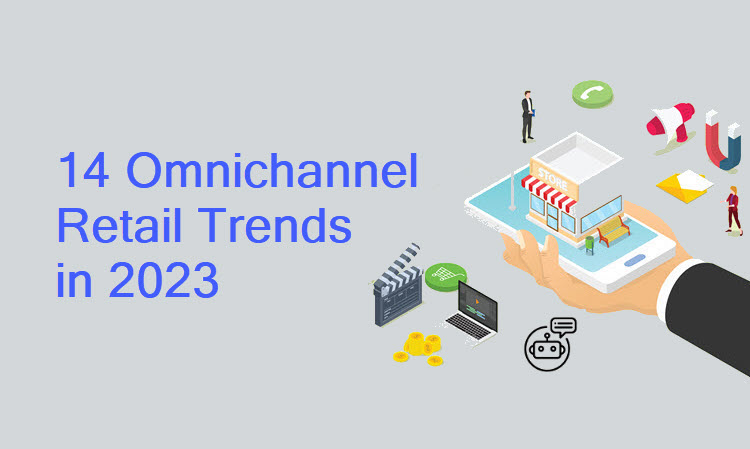It’s no news that COVID-19 transformed the shopping landscape, as hard data reveals the dramatic changes in people’s buying habits and preferences. Global ecommerce retail sales rose from 13.9% at the end of 2019 (pre-pandemic) to 19.5% in the last quarter of 2021, with a predicted gradual growth to 21.8% in 2024.
The fast growth of the mobile market and the development of machine learning in recent years has also enabled customers to search for and buy goods and services through a variety of physical and digital channels. This integration of different media has given birth to omnichannel retail – the use of multiple mutually connected channels to offer customers an integrated shopping experience.
This article explores the 14 omnichannel retail trends to watch out for in 2023 and beyond.
1. The Omnichannel Approach Gains in Popularity
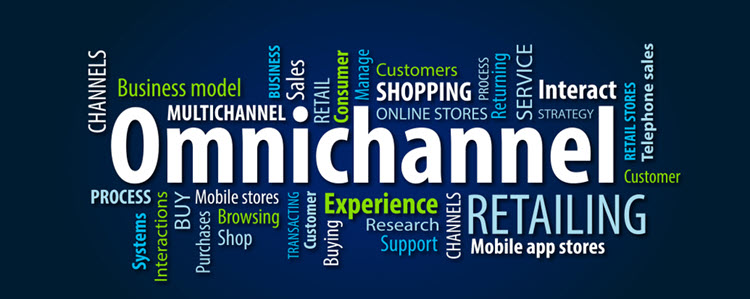
Merchants who embrace the omnichannel approach in retail generate more leads and see more conversions than businesses relying on multichannel or single channel retail. Numerous brands are already turning to omnichannel, from Disney and Macy’s to Starbucks and the Bank of America.
Customers today typically connect with six different touchpoints before choosing a particular product or service. Just fifteen years ago, they would communicate with a brand through only two points of contact. Being able to switch from a brand’s ecommerce store to their business website or social media pages, only to complete the purchase on their smartphone through the brand’s app, is what customers expect in 2023.
As omnichannel retail is gaining popularity, merchants must stay proactive and offer their customers first-class features, from an expedient customer service to a range of payment options.
Note: Learn more about omnichannel and multichannel from our article Omnichannel Vs. Multichannel: What’s the Difference?
2. The Future Is Cookie-Free
As Internet users are increasingly concerned about data security, Google is determined to change cookie settings by eliminating third-party cookies from Chrome. These cookies are created by third parties and utilized by websites to collect and analyze user data.
Google decided to remove third-party cookies a few years ago but the implementation has lagged. The cookies removal was first scheduled for 2022, but now everything has been rescheduled for 2023. Either way, business owners need to embrace this change since it will considerably influence how online customer data is gathered and stored.
Phasing out third-party cookies means that websites will soon be allowed to use only first-party cookies. These cookies are handled solely by the website’s server, and no third-party provider has access them.
It won’t be long before the digital world turns to zero-party data. Companies will not be able to track their online customers’ habits and would have to survey customers in a more direct manner about their buyer preferences.
Far-sighted merchants will work hard to build a strong sense of loyalty and trust with their customers in order to ensure they share such private data.
3. Online Stores Opening Brick-and-Mortar Stores
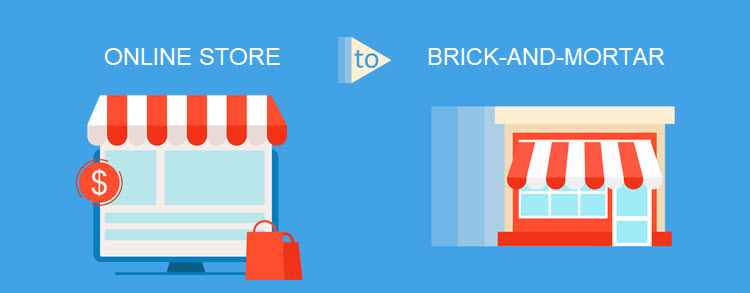
One of the main goals of omnichannel is to erase the boundaries between offline and online. Merchants moving toward omnichannel retail need to offer a unified experience across all channels.
A study published by the Interactive Advertising Bureau (IAB) shows that 30% of direct-to-customer (DTC) brands are planning to open a brick-and-mortar store to increase customer engagement.
Typically, ecommerce brands are adding brick-and-mortar stores to their digital counterparts for the following reasons:
- Local engagement. No matter how large a company is, engagement with a local audience always brings benefits. It generates additional leads and helps with the acquisition of recurring customers while gathering the local community around their brand.
- Post-pandemic, in-person buying. As the pandemic wanes, some people are tired of online shopping. They want to return to stores and touch or try on the items before a purchase.
- Affordable customer acquisition cost (CAC). Because of increasing competition online, the customer acquisition cost (CAC) in the digital environment has been rising. Therefore, connecting with potential buyers offline, in addition to an ecommerce store, could save money along the way.
Launching local brick-and-mortar stores doesn’t exclude online channels. Rather, these two retail methods work together to bring a seamless omnichannel experience.
4. The Application of Online Data to the Offline World
Merchants are using online data to better understand what customers want in the offline market. In many aspects, it’s already difficult to draw the line between offline and online touchpoints in ecommerce.
For instance, retailers prepare specialized in-store offers based on data collected through online channels. Also, merchants are combining data on individual online and offline customer habits to maximize the customer lifetime value (CLV).
Customers are also seeing the benefits of omnichannel since it guarantees they get the most bang for their buck. About 59% of customers check out a product or service online before buying it in-store, and 90% of customers prefer omnichannel shopping.
Therefore, both merchants and customers benefit from blending offline and online customer data to provide a unique omnichannel experience.
5. Showrooming Is Back
For a long time, showrooming was frowned upon by brick-and-mortar retailers. The practice involved customers going to physical stores to inspect a product they are interested in only to later buy it from an online retailer at a discount.
However, recently retailers have discovered that showrooming can help them offer a unified shopping experience: customers come to see, touch, and try a product, and then purchase it on their website at a lower price.
Another benefit of showrooming is that retailers can save money as there is less need for space since only a limited number of items are stocked in the physical store.
6. Buy Online, Pick Up In-Store (BOPIS)
Finding products and services online is convenient, but only if it is followed by timely shipping. If customers have to wait long for delivery, their frustration grows. Hence, more and more merchants offer buyers the “buy online and pick up in-store” (BOPIS or BOPUS) option.
Once the customer places an order, the merchant delivers the item to the most convenient store for the customer to pick up it. Some merchants arrange the delivery in their local store, while others open distribution centers in different locations, which is cheaper than running a full-scale store.
According to the report shared by Business Insider, the revenue generated through click-and-collect sales will have surpassed $140 billion in the US by 2024, with more than 160 million Americans using BOPIS.
7. Buy Now, Pay Later (BNPL)
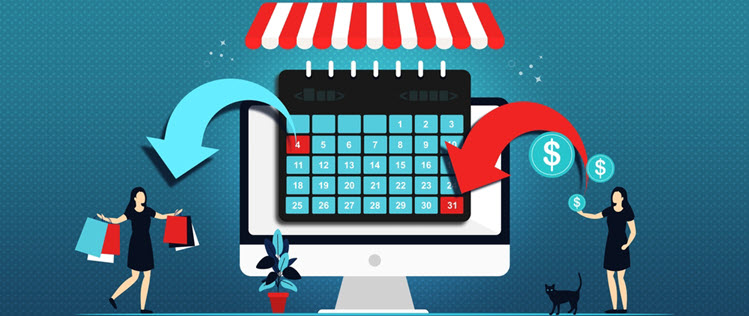
For some customers (typically impulse buyers who don’t plan shopping in advance) the best option is to buy now and pay later (BNPL). This payment option is basically a loan agreed upon between the buyer and the merchant.
Once a customer purchases an item, the total amount is split into several installments. The product price, the customer’s preferences, and the merchant’s policy dictate the total number of payments. Usually, the customer pays the first installment at checkout, while the merchant debits the customer’s card for the remaining installments in line with the pre-arranged agreement. If customers pay all installments on time, BNPL transactions typically don’t include additional interest.
In times of economic uncertainty, people prefer not spending too much cash at once.
8. Buy Online, Return in Store (BORIS)
It is no wonder that “buy online, return in store” (BORIS) is projected to be one of the most popular trends in 2023 and beyond. If a customer isn’t satisfied with the item they bought online, they can go to the brand’s local store to return or replace the product. The customer doesn’t need to contact a shipping company or go to the local mail office to send back the product. Also, the customer can sort out the refund with the shop assistants on the spot.
As reported by the National Retail Federation, the return rate of online purchases in 2021 was 20.8%, compared with 18.1% in 2020. Online buyers often wish to return an item because they realize it doesn’t suit them once they receive it.
Hence, merchants offering BORIS will make a difference since it saves their customers’ time and assets while displaying omnichannel retail in its best light.
Note: Bear in mind that a chargeback is a more complicated procedure than a refund and return.
9. Contactless Delivery
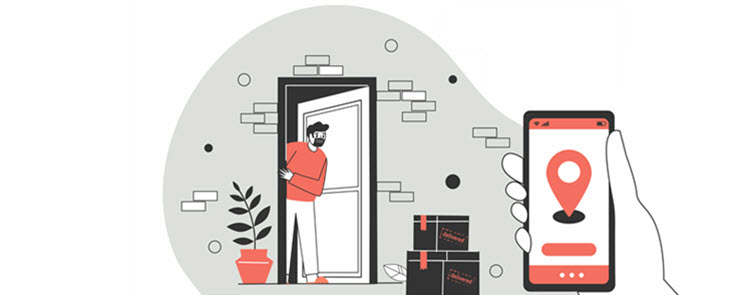
Offering contactless delivery is another feature that adds convenience to the omnichannel retail experience.
After a customer has searched for a product or service on your business website, read more about it on the blog, and gone to your social media page to see what other users say about it, it is time to make the purchase.
If you have an ecommerce app with several delivery options, you are ahead of the game. For instance, the customer might choose a contactless delivery via BOPIS, home shipment, or pickup lockers. Either way, you have provided several additional touchpoints for every loyal customer to enjoy a seamless omnichannel customer journey.
10. Social Commerce
Social commerce merges ecommerce and social media into a unified shopping experience.
As reported by Statista, there’s been a 68% upsurge in social media usage during the COVID-19 pandemic. As of April 2021, 7% of online purchases were made via social media. The further development of the mobile market and the changes in buyers’ shopping habits will have driven social commerce revenue beyond $3.37 trillion by 2028.
So, if you want to get your share of the social commerce market, 2023 is the perfect time to start selling directly through social media. From Instagram and Facebook, to TikTok and other social networks, there are many different social media channels through which merchants can achieve substantial business revenue.
11. Video Shopping

A report shared by Wyzowl shows that 73% of customers would rather watch a short video to find out more about a product or service, compared to 11% of customers who would read an article. In 2018, an average Internet user watched 1.5 hours of online video content daily, and in 2022, this number has risen to 2.5 hours per day.
This data shows that video content is the next shopping frontier for merchants aiming to deliver an omnichannel retail experience.
Merchants can now arrange live shopping sessions via online streaming channels. Instead of using traditional offline and online advertising options, companies promote their new products in real-time and connect with their customers more directly. Depending on the video shopping platform, customers are just a click or tap away from making a purchase.
12. Offer a Sense of Community
A report published by Sprout Social shows that 57% of customers are more likely to spend more if they feel properly connected with a brand. Also, 76% of customers will rather buy from such a brand than from its competitors.
Another survey shows that more than 84% of customers are more inclined to brands that share the same values.
Omnichannel retail helps merchants successfully communicate their values and activities that bring the community together. It provides multiple communication channels through which merchants can send a powerful unified message. The goal is to build and nurture a community that will promote brand values.
13. Online Shopping Assistants Are Expected

In brick-and-mortar stores, shop assistants have always been there to help customers navigate through product offerings, while more recently self-service tablets assist people wanting to learn more about specific products.
In online stores and ecommerce apps, merchants need to provide at least the same level of service using human chat agents or chatbots. Using chatbots improves the omnichannel retail experience and provides the following benefits and functionalities:
- Tracking customer behavior throughout the website and suggesting complementary or upgraded products (cross-selling and upselling).
- Helping customers find the desired product more quickly by filtering the results according to the customer’s criteria.
- Creating an amusing shopping environment through quizzes. Chatbots prepare customized offers or discounts based on customers’ answers.
- Collecting valuable customer shopping information to generate buyer personas and enhance product placement.
- Providing valuable data during the customer’s website session, such as shipping costs and delivery times, return policy information, customer support contact information, or physical addresses for brick-and-mortar stores.
- Responding to customers’ post-purchase requests, like product returns, repairs, or refunds.
The technology behind chatbots (artificial intelligence and machine learning) develops as we speak. We can expect highly advanced and even more practical chatbot options for omnichannel retail in the near future.
14. Appointment Shopping
Appointment shopping gives the edge to merchants striving to benefit from omnichannel in 2023 and beyond. Once reserved only for premium brands and VIP clients, appointment shopping has spread to all types of customers and retailers during the COVID-19 pandemic.
Retailers embraced this strategy to reduce the number of buyers in brick-and-mortar stores and meet the social distancing criteria. Then they realized that appointment shopping is a practical way of interacting with customers regardless of the pandemic.
In an appointment shopping experience, a customer tries several online digital touchpoints to gather relevant information about the brand and its products, only to schedule an in-store appointment via an online booking system or phone call and try everything in person. Once they come to the store, the merchant has more time to hear the customer’s needs and problems and offer appropriate products.
Both online and offline shopping have an important role in scheduling, performing, and completing appointment shopping with a purchase.
Conclusion
Omnichannel retail is the future of commerce in general. Customers have come to expect omnichannel benefits such as multiple interconnected sales channels, various delivery and pick-up options, and the ability to check out a product online (digitally) and in a brick-and-mortar store (physically) before making a purchase.
In the highly competitive environment of retail, it is necessary to keep your ear to the ground and be ready to adapt. The trends presented above will help you understand the directions in which the omnichannel journey is evolving and exploit the best features of new consumer habits and preferences.
